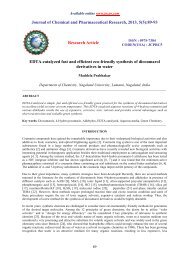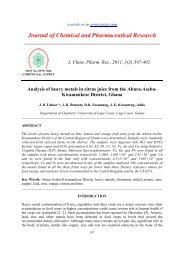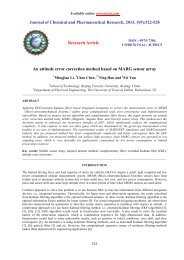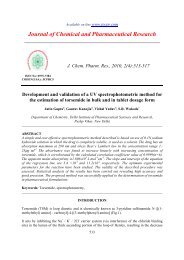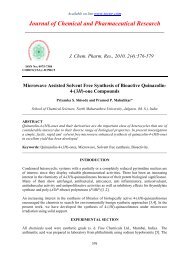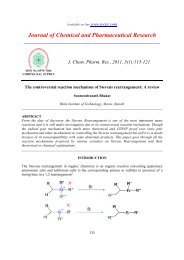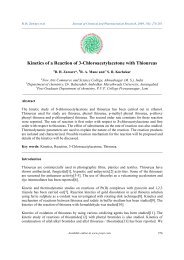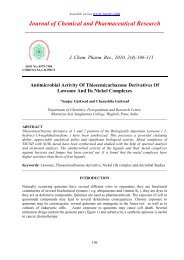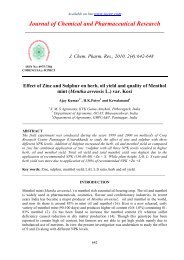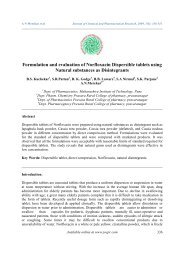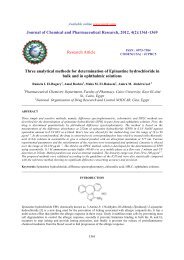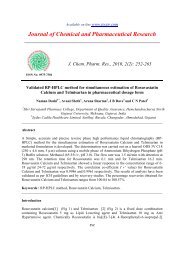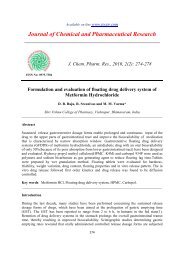Synthesis and Antimicrobial Activity of some novel Formazan
Synthesis and Antimicrobial Activity of some novel Formazan
Synthesis and Antimicrobial Activity of some novel Formazan
Create successful ePaper yourself
Turn your PDF publications into a flip-book with our unique Google optimized e-Paper software.
Available on line www.jocpr.comJournal <strong>of</strong> Chemical <strong>and</strong> Pharmaceutical Research__________________________________________________J. Chem. Pharm. Res., 2010, 2(4):60-67ISSN No: 0975-7384CODEN(USA): JCPRC5<strong>Synthesis</strong> <strong>and</strong> <strong>Antimicrobial</strong> <strong>Activity</strong> <strong>of</strong> <strong>some</strong> <strong>novel</strong> <strong>Formazan</strong>DerivativesAmarish B. Samel <strong>and</strong> N<strong>and</strong>ini R. Pai*Department <strong>of</strong> Organic Chemistry, D.G. Ruparel College, Senapati Bapat Marg, Mahim,Mumbai-400 016, India______________________________________________________________________________ABSTRACTIn the present investigation, a series <strong>of</strong> uracil formazans (5a-r) were synthesized by condensation<strong>of</strong> schiff base (4a-c) <strong>and</strong> diazonium salt <strong>of</strong> various substituted aromatic amines. The intermediateschiff base (4a-c) was itself synthesized by condensation <strong>of</strong> (6-hydrazino-3-methyl uracil) withvarious aromatic aldehydes (3a-c). The structures <strong>of</strong> the compounds have been confirmed byelemental analysis <strong>and</strong> spectral analysis. Newly synthesized compounds were screened for theirantimicrobial activities.Keywords: Schiff base, <strong>Formazan</strong>, <strong>Antimicrobial</strong> activity.______________________________________________________________________________INTRODUCTION<strong>Formazan</strong>s have been found to possess important medical applications; the tetrazolium salts areclassified as promoter <strong>of</strong> vitality formazans <strong>and</strong> heterocyclic hydrazones are known for theirspectrum <strong>of</strong> biological activities such as antiviral [1,2] antimicrobial [3], anti-inflammatory [4],antifungal [5], anticancer [6], anti-HIV [7-8], etc. Several formazans show promising antifertility[9] <strong>and</strong> anti-parkinsonian activity [10-13].The importance <strong>of</strong> uracil <strong>and</strong> its annelated substrates is well recognized by synthetic as well asbiological chemist, with the development <strong>of</strong> clinically useful anticancer (5-fluorouracil [14]) <strong>and</strong>antiviral drugs (AZT [15], BVDU [16, 17]). 6-(Arylazo) pyrimidine antimicrobials selectivelyinhibit replicative DNA synthesis in gram-positive bacteria by inhibiting, specifically, thereplication-specific enzyme, DNA polymerase III [18-20].60
N<strong>and</strong>ini R. Pai et al J. Chem. Pharm. Res., 2010, 2(4):60-67_____________________________________________________________________________In the present study we have synthesized eighteen substituted formazan derivatives (5a-r) bycoupling Schiff base prepared from 6-hydrazino-3-methylpyrimidine-2,4(1H,3H)-dione (2) <strong>and</strong>various aldehydes (3a-c) with appropriate aryl diazonium chlorides in pyridine. (Scheme 1)The structures <strong>of</strong> these derivatives were assigned on the basis <strong>of</strong> elemental analysis, IR <strong>and</strong> 1 H-NMR <strong>and</strong> 13 C-NMR spectral data. The synthesized compounds were screened for theirantimicrobial activities.EXPERIMENTAL SECTIONMelting points were determined in open capillaries on a Thomas Hoover apparatus <strong>and</strong> areuncorrected. 1 H-NMR & 13 C-NMR spectra were recorded on a Bruker AM 300 (300 MHz)instrument using tetramethylsilane (TMS) as an internal st<strong>and</strong>ard. Chemical shifts are given inparts per million (ppm). Splitting patterns are designated as follows: s- singlet, d- doublet, t-triplet, q- quartet <strong>and</strong> m- multiplet. Mass spectra (MS) were recorded on Shimadzu LC-MS. Thereactions were followed on pre-coated TLC plates (Silica gel 60 F254, Merck), visualizing thespots in ultraviolet light.Scheme-1:ONOOONNNEtOH, r.t. ONEtOH, refluxN ClO N NHHHOHCNRHNNH 21 2 3a-c4a-cR = 3a -OMe3b -Br3c -ClO1. Pyrdine,CH 3COONa2. NaNO 2, HCl,ONNHNHNN NRRH 2NH 2R'H 2N5a-rR'Target compounds 5a-r were prepared according to Scheme-1 Reaction <strong>of</strong> .6-chloro-3-methylpyrimidine-2,4(1H,3H) dione with hydrazine hydrate afforded 6-hydrazino-3-methylpyrimidine-2,4(1H,3H)-dione (2) which was further condensed with para substitutedbenzaldehyde (3a-c) in presence <strong>of</strong> ethanol as a reaction medium gave schiff base (4a-c).Formation <strong>of</strong> schiff base (3a-c) was confirmed by appearance <strong>of</strong> IR b<strong>and</strong> in the region 1650 cm -1due to -N=CH- group, 1695 cm -1 due to >C=O group <strong>of</strong> amide, 3172 cm -1 due to -NH- group(secondary amine) <strong>of</strong> schiff base, 3 <strong>and</strong> disappearance <strong>of</strong> IR b<strong>and</strong> in the region 3378 cm -1 & 1710cm -1 corresponding to -NH 2 group <strong>and</strong> -CHO group <strong>of</strong> 6-hydrazino-3-methylpyrimidine-2,4(1H,3H)-dione (2) <strong>and</strong> para substituted benzaldehyde (3a-c) respectively. 1 H-NMR spectrashowed a singlet at δ 4.9 ppm due to -N=CH- (1H) <strong>of</strong> schiff base (4a-c) <strong>and</strong> disappearance <strong>of</strong>signal δ 9.9 ppm due to –CHO (1H) <strong>of</strong> para substituted benzaldehyde (3a-c). Similarly, 13 C-NMRspectra showed a signal at δ 73.7 ppm due to -N=CH- <strong>of</strong> schiff base (4a-c). Further reaction <strong>of</strong>61
N<strong>and</strong>ini R. Pai et al J. Chem. Pharm. Res., 2010, 2(4):60-67_____________________________________________________________________________schiff base (4a-c) <strong>and</strong> diazonium salt <strong>of</strong> substituted aromatic amines in pyridine at 0-5 ºC affordedsubstituted formazans (5a-r). These compound show IR absorption b<strong>and</strong> at 1600-1615 cm -1 due to–C=N- group, 1660-1724cm -1 due to >C=O group <strong>of</strong> amide, 3250-3300 cm -1 due to -NH- group(secondary amine) <strong>and</strong> 1508-1535 cm -1 due to -N=N group <strong>and</strong> the disappearance <strong>of</strong> b<strong>and</strong>s at 1651cm -1 (-N=CH-) also confirmed the formation <strong>of</strong> 5a-r. 1 H-NMR spectra <strong>of</strong> formazans (5a-r) showsdisappearance <strong>of</strong> singlet at δ 4.9 ppm due to -N=CH- <strong>of</strong> compound 4a-c. The synthetic route <strong>of</strong>above mentioned compounds is shown in Scheme-1.Table 1. Different substituent’s for R <strong>and</strong> R’ 5a-rCompounds R R’ MP in °C % Yield5a -OCH 3 H 254 665b -OCH 3 o-CH 3 257 645c -OCH 3 o-OCH 3 245 615d -OCH 3 m-OCH 3 221 605e -OCH 3 p-OCH 3 223 635f -OCH 3 p-CL 255 625g -OCH 3 m-Cl 229 655h -OCH 3 p-F 228 635i -OCH 3 m-F 224 605j -OCH 3 p-t-butyl 180 765k -Br o-CH 3 256 745l -Br p-F 232 735m -Br m-F 254 735n -Br m-Cl 202 715o -Cl -H 246 655p -Cl o-CH 3 260 635q -Cl m-OCH 3 198 615r -Cl m-F 244 62Preparation <strong>of</strong> 6-hydrazino-3-methylpyrimidine-2,4(1H,3H)-dione (2) [21]:6-chloro-3-methylpyrimidine-2,4(1H,3H)-dione (0.003mol) <strong>and</strong> Hydrazine hydrate (0.005 mol)were added to 4 ml <strong>of</strong> methoxy ethanol in a round bottom flask. The reaction mixture was heatedto reflux for 20 minutes, cooled to room temperature <strong>and</strong> filtered. It was washed with ethanol <strong>and</strong>dried to get 6-hydrazino-3-methylpyrimidine-2,4(1H,3H)-dione in 64% yield mp:236-238ºCPreparation o f Benzyl(1-methyl-2,6-dioxo-1,2,3,6-tetrahydropyrimidin-4-yl)hydrazone(4a-c):A mixture <strong>of</strong> 6-hydrazino-3-methylpyrimidine-2,4(1H,3H)-dione (0.1 mol) <strong>and</strong> various parasubstituted benzaldehydes 3a-c (0.1 mol) in ethanol (20 mL) was stirred for 10 min at 25 o C.After the completion <strong>of</strong> reaction it was poured into ice-cold water with stirring. The solid productobtained was filtered, washed with water <strong>and</strong> recrystallized from ethanol to get Benzyl(1-methyl-2,6-dioxo-1,2,3,6-tetrahydropyrimidin-4-yl)hydrazone (4a-c).4a. Yield (85%), mp 233 o C [22]; IR: 3172 (NH),1298 (CN), 1695 (CO), 1651 (N=CH), 3107 &1514 (aromatic ring, CH & C=C) cm -1 . 1 H-NMR (300 MHz;DMSO-d6): 3.05 (3H, s, NCH 3 ),4.90 (1H, s, N=CH), 6.78 (2H, d, J = 9 Hz), 7.03 (2H, d, J = 9 Hz), 7.14 (1H, s, C=CH-CO-),10.82 (1H, s, NHCO), 10.89 (1H, s, HN-N=C); 13 C-NMR (75.5 MHz; DMSO-d6): 26.1, 73.7,113.9, 126.7, 128.8, 143.5, 150.0, 150.9, 160.5, 162.9.62
N<strong>and</strong>ini R. Pai et al J. Chem. Pharm. Res., 2010, 2(4):60-67_____________________________________________________________________________4b. Yield (80%), mp 275 o C; 1 H-NMR (300 MHz;DMSO-d6): 3.08 (3H, s, NCH 3 ), 4.91 (1H, s,N=CH), 7.57 (2H, d, J = 9 Hz), 7.83 (2H, d, J = 9 Hz), 7.93 (1H, s, C=CH-CO-), 11.01 (1H, s,NHCO), 11.18 (1H, s, HN-N=C); 13 C-NMR (75.5 MHz; DMSO-d6): 24.6, 72.9, 121.2, 127.6,129.9, 131.9, 140.7, 148.4, 149.4, 161.4.4c. Yield (81%), mp 260 o C [22]; 1 H-NMR (300 MHz;DMSO-d6): 3.09 (3H, s, NCH 3 ), 4.91 (1H,s, N=CH), 7.57 (2H, d, J = 9 Hz), 7.93 (2H, d, J = 9 Hz), 7.96 (1H, s, C=CH-CO-), 11.01 (1H, s,NHCO), 11.17 (1H, s, HN-N=C); 13 C-NMR (75.5 MHz; DMSO-d6): 26.1, 74.4, 128.5, 128.9,129.9, 142.1, 149.9, 150.9, 160.5, 162.9.Preparation <strong>of</strong> uracil formazans (5a-r) [23]:Substituted anilines (0.01 mole) were dissolved in aq. HCl (10 mL). It was cooled <strong>and</strong> aq.NaNO 2 (0.7g) was slowly added. Benzyl (1-methyl-2,6-dioxo-1,2,3,6-tetrahydropyrimidin-4-yl)hydrazone (0.01 mole) was dissolved in dry pyridine (10 mL) <strong>and</strong> sodium acetate (0.3 g) wasadded. The contents were cooled in an ice-bath <strong>and</strong> stirred. To it a clear <strong>and</strong> cold solution <strong>of</strong>diazonium salt <strong>of</strong> substituted anilines was added drop wise for 1 hr at low temperature (0-5°C).The reaction mixture was kept in ice-bath for 5 min <strong>and</strong> then poured into ice water. The resultingdark coloured mass was collected by filtration, washed with water till it was free from pyridine<strong>and</strong> dried. The product was crystallized from ethanol. (5a-r).5a. IR: 3265 (NH), 1724,1668 (>C=O <strong>of</strong> amide, C=O str.), 1608 (-N=CC=O <strong>of</strong> amide, C=O str.), 1608 (-N=CC=O <strong>of</strong> amide, C=O str.), 1612 (-N=CC=O <strong>of</strong> amide, C=O str.), 1605 (-N=CC=O <strong>of</strong> amide, C=O str.), 1606 (-N=CC=O <strong>of</strong> amide, C=O str.), 1608 (-N=C
N<strong>and</strong>ini R. Pai et al J. Chem. Pharm. Res., 2010, 2(4):60-67_____________________________________________________________________________(3H, s, -N-CH 3 ), 3.89 (3H, s, Ar -OCH 3 ), 6.98- 7.80 (8H, m, Ar-H), 8.45 (1H, s,C=CH), 9.35(1H, s, NHCO), 14.91 (1H, s, HN-N=C); 13 C-NMR (75.5 MHz; CDCl 3 ): 27.8, 55.5, 114.5,116.3, 116.6, 118.0, 118.1, 126.1, 130.5, 138.1, 147.0, 148.6, 158.9, 160.0, 162.8, ; MS m/z:396.5g. IR: 3265 (NH), 1724,1668 (>C=O <strong>of</strong> amide, C=O str.), 1608 (-N=CC=O <strong>of</strong> amide, C=O str.), 1606 (-N=CC=O <strong>of</strong> amide, C=O str.), 1606 (-N=CC=O <strong>of</strong> amide, C=O str.), 1606 (-N=CC=O <strong>of</strong> amide, C=O str.), 1612 (-N=CC=O <strong>of</strong> amide, C=O str.), 1608 (-N=CC=O <strong>of</strong> amide, C=O str.), 1612 (-N=CC=O <strong>of</strong> amide, C=O str.), 1612 (-N=C
N<strong>and</strong>ini R. Pai et al J. Chem. Pharm. Res., 2010, 2(4):60-67_____________________________________________________________________________5o. IR: 3265 (NH), 1724,1668 (>C=O <strong>of</strong> amide, C=O str.), 1608 (-N=CC=O <strong>of</strong> amide, C=O str.), 1608 (-N=CC=O <strong>of</strong> amide, C=O str.), 1612 (-N=CC=O <strong>of</strong> amide, C=O str.), 1612 (-N=C
N<strong>and</strong>ini R. Pai et al J. Chem. Pharm. Res., 2010, 2(4):60-67_____________________________________________________________________________<strong>Antimicrobial</strong> activityThe synthesized compounds 5a-r were screened for their antibacterial activity against E. Coli<strong>and</strong> S.Aureus <strong>and</strong> antifungal activity against S.Cerevisiae <strong>and</strong> C.albicans at a concentration <strong>of</strong> 60µg/mL in DMF by cup-plate method [24, 25]. St<strong>and</strong>ard anti-bacterial <strong>and</strong> antifungal drug,gentamycin <strong>and</strong> miconazole respectively were also tested under similar conditions forcomparison. Zone <strong>of</strong> inhibition in mm <strong>of</strong> synthesized compounds <strong>and</strong> st<strong>and</strong>ard drugs are shownin Table 2.CONCLUSIONA series <strong>of</strong> <strong>novel</strong> uracil formazans (5a-r) were synthesized, the structures <strong>of</strong> the compounds havebeen confirmed by elemental analysis <strong>and</strong> spectral analysis. Most <strong>of</strong> the synthesized compoundshave shown antibacterial <strong>and</strong> antifungal activity to <strong>some</strong> extent. Among the synthesizedcompounds, 5c <strong>and</strong> 5n show <strong>some</strong> activity, while rest show feeble activity against E. coli.Against S.Aureus the compound 5o shows good activity, while compounds 5k <strong>and</strong> 5p showmoderate activity. The remaining compounds have been found to be less active against S.Aureus.The compound 5j shows good activity, while compounds 5a, 5c, 5i, <strong>and</strong> 5r show moderateactivity against S.Cerevisiaec The compounds 5b <strong>and</strong> 5f show good activity while compounds 5e<strong>and</strong> 5j show moderate to good activity against C. albicans.Acknowledgements:The authors are thankful to BASF India Ltd. for providing analytical support.REFERENCES[1] V.K.P<strong>and</strong>ey <strong>and</strong> H.S.Negi, Indian Drugs (Indian Drug Manufacturers Association), 1999,36(1), 37.[2] V S Mishra, S Dhar <strong>and</strong> B L Chowdhary, Pharmazie, 1978, 33, 790[3] R M Desai <strong>and</strong> J M Desai, Indian J Heterocycl Chem., 1999, 8(4), 329[4] H G Garg <strong>and</strong> M, J Kaur Med Chem., 1992, 15, 554.[5] K G Desai <strong>and</strong> K R Desai, Indian J Chem., 2005, 44(B), 2097.[6] S D Bhardwaj, P Phatak <strong>and</strong> V S Jolly, Orient J Chem., 1995, 2, 181.[7] N K Venkal, J Med Chem., 1998, 8, 11.[8] S D Bhardwaj <strong>and</strong> V S, Jolly Asian J Chem., 1997, 9, 48.[9] J M Desai <strong>and</strong> V H Shah, Indian J Chem., 2003, 42(B), 631.[10] R.Khanna, A.K.Saxena, V.K.Srivastava <strong>and</strong> K.Shanker, Indian J Chem., 1990,29(B), 91.[11] P.Kumar, C.Nath, J.C.Agarwal, K.P.Bhargava <strong>and</strong> K.Shanker, Indian J Chem.,1983,22(B), 955.[12] Naithani P K, Srivastava V K, Barthwal J P, Saxena A K, Gupta T K <strong>and</strong> Shanker K,IndianJ Chem., 1989, 28(B), 990.[13] P.Kumar, C.Nath <strong>and</strong> K.Shanker, Pharmazie, 1985, 40, 267.[14] C.Heidelberger, F. J. Arafield, Cancer Res. 1963,23,1226;Chem.Abstr. 1964, 60, 2197.[15] E. D. Clercq, J. Med. Chem. 1986, 29, 1561.[16] E. D. Clercq, Anticancer Res. 1986, 6, 549.[17] S. Jones, G. Verhalst, R. T. Walker, Tetrahedron Lett. 1974, 4415.[18] M. M. Neville <strong>and</strong> N. C. Brown, Nature (London), New Biol., 240, 80 (1972).[19] G. W. Bazill <strong>and</strong> J. D. Gross, Nature (London), New Biol., 240, 82 (1972).[20] K. B. Gass, R. L. Low, <strong>and</strong> N. R. Cozzarelli, Proc. Natl. Acad. Sci. U.S.A., 70, 103 (1973).[21] T. K.Liao, F.Baiocch, C. C. Cheng J. Organic chem.1966, 31, 900-90266
N<strong>and</strong>ini R. Pai et al J. Chem. Pharm. Res., 2010, 2(4):60-67_____________________________________________________________________________[22] F. Yoneda, T. Nagamatsu <strong>Synthesis</strong> 1973, 5, 300-01.[23] Raval et al, International Journal <strong>of</strong> Pharmaceutical Research 2009, 1, 62-71.[24] L. Banty, The <strong>Antimicrobial</strong> Susceptibility test; Principle <strong>and</strong> practice, Edited by Illus lea<strong>and</strong> Febiger, (Philadelphia, Pa USA), 1976, 180.[25] H .W. Seely <strong>and</strong> P. J. Van Demark, Microbes in action: A laboratory manual <strong>of</strong>Microbiology, D B Taraporewala Sons <strong>and</strong> Co, Bombay, 1975, 55-80.67



